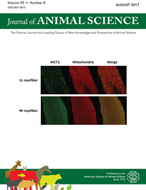-
Views
-
Cite
Cite
B. L. Creech, J. W. Spears, W. L. Flowers, G. M. Hill, K. E. Lloyd, T. A. Armstrong, T. E. Engle, Effect of dietary trace mineral concentration and source (inorganic vs. chelated) on performance, mineral status, and fecal mineral excretion in pigs from weaning through finishing, Journal of Animal Science, Volume 82, Issue 7, July 2004, Pages 2140–2147, https://doi.org/10.2527/2004.8272140x
Close - Share Icon Share
ABSTRACT
Two hundred and sixteen weanling gilts (6.65 ± 0.08 kg) were used to determine the effects of decreasing supplemental concentrations of Zn, Cu, Fe, and Mn, and trace mineral source (inorganic vs. chelated) on growth performance, mineral status, and fecal mineral concentrations from weaning through development. The study was conducted over three trials with 72 pigs in each trial. Gilts were blocked by weight and randomly assigned to either 1) control, 2) reduced inorganic, or 3) reduced chelated trace minerals. The control diet was supplemented with 25, 150, 180, and 60 mg/kg of Cu, Zn, Fe, and Mn (in sulfate forms), respectively, during the nursery phase and 15, 100, 100, and 40 mg/kg of supplemental Cu, Zn, Fe, and Mn, respectively, during the growing and gilt-developer phases. Reduced inorganic and reduced chelated treatments were supplemented during all phases with 5, 25, 25, and 10 mg/kg of Cu, Zn, Fe, and Mn, respectively. The reduced chelated treatment supplied 50% of the supplemental Cu, Zn, Fe, and Mn in the form of metal proteinates, with the remainder from sulfate forms. Performance by control pigs did not differ from pigs fed the reduced trace mineral treatments during the nursery and grower-development periods. Gain:feed was lower (P < 0.05) for pigs fed the reduced inorganic compared with those fed the reduced chelated treatment during the nursery period. Trace mineral source did not affect performance during the growing or gilt-developer phase. Plasma Zn concentration and alkaline phosphatase activity were higher (P < 0.01) in control pigs than in those receiving reduced trace minerals during the nursery and growing phases. Plasma Cu concentration and ceruloplasmin activity were generally not affected by treatment. Hemoglobin concentrations were lower (P < 0.05) for the reduced inorganic compared with the reduced chelated treatment in the nursery phase. Fecal concentrations of Cu, Zn, and Mn were lower (P < 0.05) in pigs fed reduced trace minerals than in controls during all production phases. Fecal Zn concentration during the nursery and fecal Cu concentrations during the growing and gilt-developer phases were lower (P < 0.05) in pigs fed the reduced chelated compared with the reduced inorganic treatment. Results indicate that reducing the concentrations of Zn, Cu, Mn, and Fe typically supplemented to pig diets will greatly decrease fecal mineral excretion without negatively affecting pig performance from weaning through development.





